Chapter 17. Well-Being
WB.29: Case Study – The Impact of Negative Affectivity on Cardiovascular Health and Behaviour in a Young Athlete
Approximate reading time: 3 minutes
Background
Sarah, a 17-year-old high school student, is not only a star hockey player but also struggles with negative affectivity, a personality trait characterized by persistent distressing emotions.
Case Presentation
Sarah’s exceptional skills in hockey are often overshadowed by her emotional struggles. She frequently experiences intense feelings of anger, contempt, disgust, guilt, fear, and nervousness. These emotions are not just momentary; they are deeply ingrained in her personality and affect her daily life.

In addition to the emotional turmoil, Sarah’s negative affectivity affects her ability to participate in her big love in life — hockey. She often gets called out by referees for roughing up and yelling at other players. This aggressive behaviour results in Sarah spending significant time on the penalty bench, detracting from her participation in the sport she loves and excels in.
Psychological Analysis
Sarah’s behaviour on the ice can be directly linked to her negative affectivity, as described by Watson, Clark, and Tellegen (1988). This persistent state of negative emotions affects her stress response, leading to aggressive behaviour in high-pressure situations like competitive sports.
Physiological Implications
The chronic stress associated with negative affectivity and aggressive behaviour poses a risk to Sarah’s cardiovascular health. The constant activation of stress responses can contribute to the development of hypertension and heart disease (Suls & Bunde, 2005). For a young athlete like Sarah, this is particularly concerning as it can affect both her physical health and athletic career.
Conclusion
Sarah’s case underscores the complex interplay between psychological states, behaviour, and physical health. Her negative affectivity not only impacts her emotional well-being but also manifests in aggressive behaviour, affecting her participation in hockey. Addressing these challenges through psychological and behavioural interventions is crucial for her overall well-being and continued success in her sport. As Sarah enters therapy and learns to manage her emotions and reactions more effectively, it is anticipated that her mental health, behaviour on the ice, and physical health will improve.
Image Attributions
Figure SUP WB.6. Emotional turmoil by Rachel Lu is licensed under a CC BY-NC-SA license.
To calculate this time, we used a reading speed of 150 words per minute and then added extra time to account for images and videos. This is just to give you a rough idea of the length of the chapter section. How long it will take you to engage with this chapter will vary greatly depending on all sorts of things (the complexity of the content, your ability to focus, etc).

